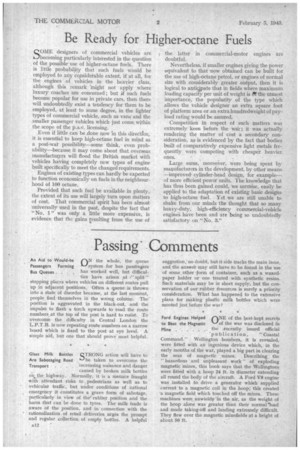Be Ready for Higher-octane Fuels
Page 14

If you've noticed an error in this article please click here to report it so we can fix it.
SUME designers of commercial vehicles are becoming particularly interested in the question . of the possibleuse of higher-octane fuels. There is little probability that such fuels wOuld be employed to any co,nSiderable extent, if at all, for the engines of vehicles in the heayier class, although this remark 'might not apply where luxury coaches are concerned ; but if such fuels become popular for use in private cars, then there will undoubtedly exist a tendency for them to be employed, at least to some degree, in the lighter types of commercial vehicle, such as yangand the _smaller passenger vehicles which just come, within the scope of the p.s.v. licensing.
Even if little can be done now in this directron, it is essential to keep high-octane fuel in mind as a post-war possibility—some think, even prob'ability—because it may come about that overseas manufacturers will flood the British market with vehicles having completely new types of engine built specifically to meet the changed requirements.
Engines of existing types can hardly be expected to function economically on fuels in the neighbourhood of 100 octane.
Provided that such fuel be available in plenty, the extent of its use will largely turn upon matters of cost. That commercial spirit has been almost universally used in the past, despite the fact that "No. 1" was only a little more expensive, is evidence that the gains resulting from the use of • the latter in commercial-motor engines are doubtful.
Nevertheless, if smaller engines giving the power . equivalent to that -now obtained can be built for the use of high-Octane petrol, or engines of normal size with considerably greater output, then it is logical to anticipate that in fields where maximum loading capacify per unit of weight is et the ntmost importance, the popularity of the type which allows the vehicle designer an extra square foot of platform area or an extra hundredweight.of payload rating wOuld be assured.
Competition in respect of such matters was extremely keen before the war; it was actually • rendering the matter of cost a secondary consideration, as. is .evidenced by the fact that bodies built of cbmparatively expensive light metals frequently were competing with cheaper heavier. ones.
Large sums, moreover, were being spent by manufacturers in the development, by other means —improvedcylinder-head design, for example—. of more efficient power units. The knowledge that has thus been gained could, we surmise, easily be applied to the adaptation of existing basic designs• to high-octane fuel. Yet, we are still unable to shake from our minds the thought that so many heavy-duty, high-efficiency commercial-vehicle engine i have' been and are being so undoubtedly satisfactory on "No. 3."




















































